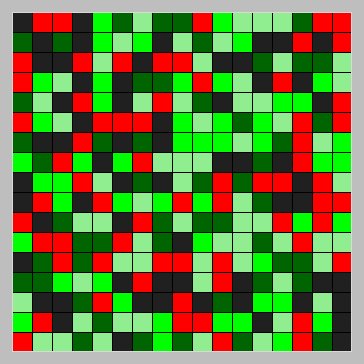







Images are ordered horizontally starting from Day 1 to Day 8
For this assignment, you will create Python source files containing a function(s) implementing each of the problems described below. If you find it useful for any of the problems in this assignment, you may define additional helper functions that your primary function for that problem calls to solve a sub-problem. Definitions for these helper functions should be included in the same Python source file as the primary function they help. You should store a source file for each problem in a folder named pa10.
Note: You are responsible for protecting your solutions to these problems from being seen by other students either physically (e.g., by looking over your shoulder) or electronically. (More information can be found in the instructions for Programming Assignment 2.)
In this assignment, you will develop a simple graphical simulation that analyzes how forest fires spread and how forests regrow after fires. Each time step of the simulation represents one day.
On each day, if a tree is on fire, it may turn to ashes. If a tree is ashes, it may turn into a shoot (a baby tree). If a tree is a shoot, it may starting growing. If a tree is growing, it may reach maturity. If a tree is mature and at least one of its neighbors is on fire, it may ignite (i.e., catch on fire itself).
This simulation will show how a small forest, represented by a 17 × 17 matrix of trees, evolves over time.
Here is a sample of what the first eight "days" of the simulation might look like:








Images are ordered horizontally starting from Day 1 to Day 8
Each snapshot above is a time step of the simulation shown in a 340 × 340 window (in pixels). Notice that the window is "divided" up into 17 × 17 squares. Each of these 289 squares represents one tree in the simulated forest.
In addition to the display functionality provided by the Canvas module, you will also need to use random number generation in this simulation. Suppose an event occurs with a chance of 20 percent. We can write a function that returns true if the event occurs and false otherwise given that the chance of the event happening is 20%:
from random import *
def event():
if (randrange(100) < 20):
return True
else:
return False
Assuming the randrange generator is uniform, then this returns true if randrange(100) is 0 through 19, and false if randrange(100) is 20 through 99. So 20% of the values will cause the function to return true.
More concisely and more generally, for a chance of p percent, where p is between 0 and 100, inclusive:
def event(p): return (randrange(100) < p)Note: whenever you see code of the form "if x: return True ...", notice that the expression x is already a Boolean value, so you can simply return x rather than testing it and returning True or False. Here, x is "randrange(100) < p". Notice how much more concise this is compared to the event definition shown previously. Using the Boolean value of a conditional directly is a common programming idiom. In the file display.py you are given the functions display(forest) and test_display(). The parameter forest is a 17 × 17 matrix representing the 289 trees of the forest for the simuation. Each tree is a cell of the matrix. Each cell has an integer in the range 0 through 4 (inclusive), which encodes the tree's state as follows:
0 on fire 1 in ashes 2 a shoot (i.e. baby tree) 3 growing tree 4 mature tree
The function display(forest) goes through the entire matrix and displays each "tree" as a square of size 20 pixels × 20 pixels in one of the following colors:
"red" on fire "#202020" in ashes (this is a dark gray) "lightgreen" a shoot "green" growing tree "darkgreen" mature treeThe function display(forest) can be tested by using test_display.py, which creates a matrix of size 17 × 17 and fills each cell with a random integer between 0 and 4.
Sample Usage:
>> load "display.py" => true >> load "test_display.py" => true >> test_display()

Your image may differ.
Complete the problems below to build this forest fire simulation in Python:
[4 points] Next, you will write 3 functions to test a specific tree in the forest to see if it changes its state. Complete all of these functions in the file tests.py, which should probably begin like this:
from random import randrange
FIRE = 0
ASHES = 1
SHOOT = 2
GROWING = 3
MATURE = 4
def event(p):
# return True p percent of the time
return randrange(100) < p
Add functions to the file as specified below:
General algorithm: Test to see if the cell forest[i][j] represents a tree on fire and use the event function above to see if it returns true given the percentage p. If both of these conditions are true, then return true. Otherwise, return false.
General algorithm: Test to see if the cell forest[i][j] represents a tree that is not on fire and is not mature, and then use the event function above to see if it returns true given the percentage p. If both of these conditions are true, then return true. Otherwise, return false.
General algorithm: Test to see if the cell forest[i][j] represents a tree that is mature, then test to see if at least one of its neighbors is on fire, and then use the event function above to see if it returns true given the percentage p. If both of these conditions are true, then return true. Otherwise, return false.
NOTE: Be careful when you test the neighbors. You might be on the edge of the forest. If you test for a neighbor and you go off of the matrix, you might cause your program to crash. It will help here to look at each neighbor separately rather than trying to evaluate all four neighbors in one statement.
Test your burnout function. Add the following code to tests.py:
def test_burnout():
forest = [ [0, 0, 0, 0, 0], [0, 0, 0, 0, 0], [1, 2, 3, 4, 4] ]
for i in range(len(forest)):
for j in range(len(forest[i])):
print(burnout(forest, i, j, 20), end = " ")
print()
which creates a simple small forest of
size 3 × 5 and calls burnout directly on each cell, printing the
results.
Sample usage:
$ python3 -i tests.py >>> test_burnout() False True False False False False False False False True False False False False FalseThe first two rows should each contain, on average, one true value. For the last row, all outputs should be false.
Write two additional test functions to test grows and ignites.
The basic idea here is that we start with the current forest in the array forest and create a new snapshot of the forest after one time step in an array new_forest. Each cell new_forest[row][column] represents the new status of the cell in the forest from forest[row][column].
General Algorithm:
Since your update function will depend on functions in tests.py, you should import these functions by adding this line to update.py:
from tests import *
Test your update function using the run_simulation function in simulation.py, which creates a random forest and runs the simulation for 100 "days". Sample usage:
$ python3 -i simulation.py >>> run_simulation()
Alternatively, you might call run_simulation(step = True) instead of run_simulation(); this steps through the simulation day by day, waiting for you to hit enter to advance to the next day, rather than sleeping for a set amount of time.
If you do this part correctly, the first 8 days of your simulation should match the pictures at the beginning of this assignment. You can change the seed for the random number generator later to try out other simulations, and you can change the chances for cool, grow and ignite to see how these effect the simulation once you're done.
The function call run_simulation(init = 'n') is similar to run_simulation(init = 'wall'), except that it calls the function fire_wall_n() to create the initial forest instead of fire_wall_forest() (see the code in simulation.py. Your job is to define fire_all_n within simulation.py to complete the program.
fire_wall_n() is similar to fire_wall_forest() except that instead of setting the entire top row of trees on fire, it prompts the user for a number n, and then sets the first n trees on fire. So if the user entered the number 8, the initial state of the forest would be random values between 1 and 4, except that forest[0][0] through forest[0][7] would start out at 0 (on fire). If the user enters a value for n that is less than 0 or greater than 17, the function should require entering a value again. (Use a while loop for this.)
Hint: The input() method returns a string. If you need to convert a string to an integer you can use the int method. For example, the assignment statement
n = int(input("How many trees initially on fire? "))
assigns to the variable n the integer value of the command
line input provided by the user.
With this approach, your program will stop with an error if the user types in a non-integer, because it is an error to try to convert a non-integer string using int. You can assume users are good typists, but be aware that writing fragile input functions with no error checking is usually a very bad idea.
You should now have a pa10 directory that contains the required files tests.py, update.py, and simulation.py each—in turn—containing the corresponding function(s). You do not have to hand in the testing functions since we will have copies of these. Zip up your directory and upload it using the handin system. (The handin system will accept submissions until the deadline Tuesday night.